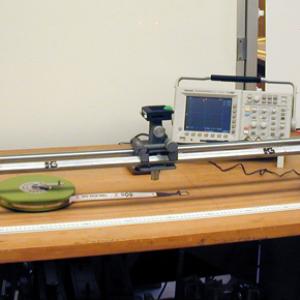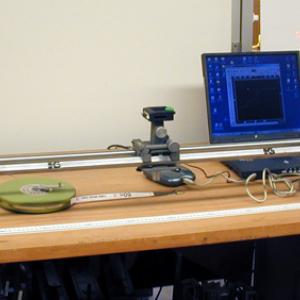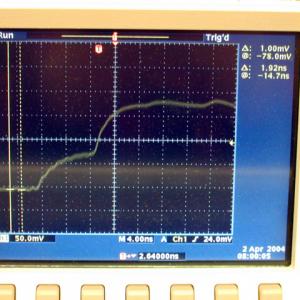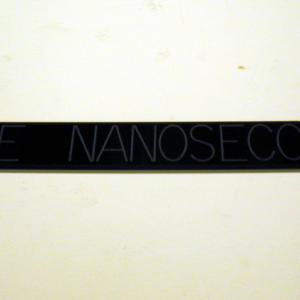College of Liberal Arts & Sciences
6A01.05 - Speed of Light - Laser Diode
Align the pulser unit and the corner cube when they are separated by a distance of 1.25 meters ( total path = 2.5 m ). Either the digital scope or the laptop with interface can be used depending on what type of projection you want to do. The digital scope usually has less noise when the corner cube is moved. You will get a single rise curve for a single path and a double rise curve for the two paths. The part of the curve to measure is the first full rise (time of the sent pulse and its return from the corner cube). Both the digital scope and the laptop have cursers that can measure directly the time for that distance traveled.
An interesting experiment to try is the measurement of the index of refraction of another medium such as Plexiglas. Place the Plexiglas block into the light path and measure the change in the path time difference between the air and the Plexiglas.
- Tom Ekkens, "Raspberry Pi Physics: Measuring the Speed of Light", TPT, Vol. 62, #1, Jan. 2024, p. 22.
- Robert P. Bauman, "Wave Propagation", TPT, Vol. 39, # 9, Dec. 2001, p. 545.
- W. Larry Freeman, "The Velocity-of-Light Apparatus by PHYWE - An Evaluation", TPT, Vol. 35, # 5, May 1997, p. 295.
- John E. Carlson, "Speed of Light Measurement with the Laser Pointer", TPT, Vol. 34, # 3, p. 176-177, March 1996.
- Allan Feldman, "The Speed of Light in Different Media", TPT, Vol. 29, # 2, Feb. 1991, p. 112.
- "Heavy Conversation on a Light Topic", TPT, Vol. 24, # 1, Jan. 1986, A Physics Student Newsletter, Vol. 1, # 1.
- Che-Chung Chou, Shi-Yu Hsaio, Jun-Zhi Feng, et al, "A Tabletop Experiment for Speed of Light Measurement Using a Red Pitaya STEMlab Board", AJP, Vol. 91, #3, March 2023, p. 206.
- Abdulaziz M. Aljalal, "Speed of Light Measurement with a Picosecond Diode Laser and a Voltage-Controlled Oscillator", AJP, Vol. 90, #12, Dec. 2022, p. 935.
- E. D. Greaves, An Michel Rodriguez, J. Ruiz-Camacho, "Erratum: "A One-Way Speed of Light Experiment" ", AJP, Vol. 78, # 8, p. 878, Aug. 2010.
- J. Finkelstein, "Comment on "A One Way Speed of Light Experiment", by E. D. Greaves, An Michel Rodriguez, J. Ruiz-Camacho", AJP, Vol. 78, # 8, p. 877, Aug. 2010.
- Jed Brody, Laura Griffin, Phil Segre, "Measurements of the Speed of Light in Water Using Foucault's Technique", AJP, Vol. 78, # 6, June 2010, p. 650.
- E.D. Greaves, Michel Rodriguez, J. Ruiz-Camacho, "A One-Way Speed of Light Experiment", AJP, Vol. 77, # 10, Oct. 2009, p. 894.
- Kenichiro Aoki, Takahisa Mitsui, "A Tabletop Experiment for the Direct Measurement of the Speed of Light", AJP, Vol. 76, # 9, p. 812, Sept. 2008.
- George W. Clark, "An Electrical Measurement of the Speed of Light", AJP, # 2, Feb. 2001, p. 110.
- R. E. Crandall, "Minimal Apparatus for the Speed-of-Light Measurement", AJP, Vol. 50, # 12, Dec. 1982, p. 1157.
- Darryl Thayer, "Another Speed of Light Apparatus", AJP, Vol. 41, #5, May 1973, p. 722.
- D. T. Phillips and R. Thompson, "Speed of Light with N2 Laser", AJP, Vol. 38, #11, Nov. 1970, p. 1353.
- T. Kallard, "Measurement of the Speed of Light", Exploring Laser Light, p. 76.
- "Velocity of Light Demonstration Using a New Short-Duration Pulsed-Light Source", Apparatus Notes, July 1965-December 1972, p. 27.
- Yaakov Kraftmakher, "4.7, Speed of Light", Experiments and Demonstrations in Physics, ISBN 981-256-602-3, p. 257.
- R. Weinstein, "Apparatus for Direct Measurement of the Velocity of Light", Apparatus Notes, July 1965-December 1972, p. 97.
Disclaimer: These demonstrations are provided only for illustrative use by persons affiliated with The University of Iowa and only under the direction of a trained instructor or physicist. The University of Iowa is not responsible for demonstrations performed by those using their own equipment or who choose to use this reference material for their own purpose. The demonstrations included here are within the public domain and can be found in materials contained in libraries, bookstores, and through electronic sources. Performing all or any portion of any of these demonstrations, with or without revisions not depicted here entails inherent risks. These risks include, without limitation, bodily injury (and possibly death), including risks to health that may be temporary or permanent and that may exacerbate a pre-existing medical condition; and property loss or damage. Anyone performing any part of these demonstrations, even with revisions, knowingly and voluntarily assumes all risks associated with them.




